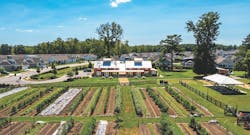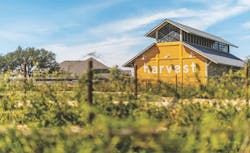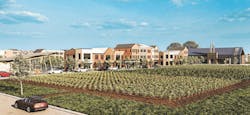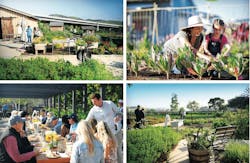Time was that golf courses and clubhouses, fitness centers, and pools ruled the community amenities offered in master planned communities (MPCs). Then it was collaborative “makerspaces,” dog-friendly commons, and more recently, pickleball courts.
But as land has become less available and more expensive, fewer master plan developers are teeing up golf courses. A number of them are using that land for rows of crops and groves of olive and citrus trees, creating “agrihoods” that not only feed an increasing consumer desire for health and wellness but also offer greater opportunity for community connection and what has become an enticement for homebuyers in a competitive market.
Already a budding trend pre-pandemic, health and wellness continue to overlay everything from food to fashion to housing. “During COVID, nobody wanted to sit at the pools or exercise in the gyms; they were all outside walking the trails,” says developer Tom Woliver, co-president of Oxland Group, in McKinney, Texas. “We’ve doubled down on nature as the new amenity.”
Although located mostly in the South and West, there are an estimated 200 agrihoods across the U.S. in at least 30 states, in rural communities to major cities.
A 2018 study by the Urban Land Institute (ULI) revealed that certain jurisdictions also award faster zoning approvals and entitlements for agrihoods, which helps to reduce project costs. In addition, the study found there’s increased buy-in from stakeholders, including public officials and investors, as well as the opportunity for local, state, or federal incentives that reduce project costs through tax exemptions, reductions, and rebates. In short, food is becoming smart business for developers.
Agrihoods: More Than a Garden
At a basic level, agrihoods are communities that feature a sincere farming component. While the definition can encompass several different models, an agrihood is not just a community garden but a working farm that produces food and can result in other benefits for the residents and even for the wider community beyond the MPC.
“For us, it’s really important that there’s enough agriculture that it forces [a community’s] farmers to grow the food in the way small farms actually grow food,” says Scott Snodgrass, a partner in Agmenity, a Houston-based consultancy that also designs, installs, and manages agricultural amenities for master planned communities. Additionally, Agmenity is a partner in Meristem Communities, a Houston development firm.
Although located mostly in the South and West, there are an estimated 200 agrihoods across the U.S. in at least 30 states, in rural communities to major cities, as Ed McMahon, a senior fellow of sustainable development at ULI, told Civil Eats, a nonprofit publication focused on sustainable food news. Examples of agrihoods include everything from upscale Serenbe southwest of Atlanta to Aria Denver, which features 72 affordable apartments and 13 townhouses as well as a production garden and greenhouse.
Farm size depends on a community’s goals. “In one community, we have an acre-and-a-half site that serves 3,000 homes,” Snodgrass says. “For the interest level of that community, it does the trick.”
Bringing in designers early on will help to determine the right size for the farm component. “If it’s too small, it’s not big enough to be operated by a bigger entity. If it’s too big, then it’s not human scale and it feels like you’re living on an actual farm rather than having this amenity for the community,” says Chris Fernandez, director of planning at architecture, planning, and interiors firm Dahlin, headquartered in Pleasanton, Calif., which is currently working on the master plan for Indigo, an agrihood in Richmond, Texas, being developed by Meristem Communities. “[The farm component is] no different than a community center: If it’s too big, it feels empty and doesn’t feel like it’s being utilized. And if it’s too small, it’s always crowded and you can never get to use any of the amenities in it.”
One question Agmenity gets a lot, Snodgrass says, is where to put the farm within the master plan. He advises clients to stay out of floodplains (just in case they actually flood) but says other than that, “there are all sorts of options. You can even put the farm in places that don’t have good soil.” Marginal land that developers otherwise can’t dig into for utility easements and similar uses also is fertile ground for the farm setup.
RELATED
- A Traditional Idea Made New: Agrihoods
- The Patch: an Agrihood in the City
- Agrihoods Draw Homebuyers Back to the Land
The most successful agrihoods, however, seem to be those where community goals determine the farm’s location; in those cases, the placement is intentional instead of being an afterthought to use leftover land.
At Rancho Mission Viejo, a 23,000-acre master plan in Orange County, Calif., the first village in the development, Sendero, located its farm on the edge of the community. But several years later, a second-phase village, Esencia, sited its farm in the middle of the parcel in response to residents’ high level of interest in the farm’s community-building potential. “It sits at the top of an oak canyon we preserved, and there’s a daycare across the street and some higher-density housing,” says architect Andrew Watkins, principal at JZMK Partners, in Costa Mesa, Calif., which has worked on several phases of the master plan. “They all work together as a core for that development. It’s a central part of the community’s identity and is a way to attract new residents.”
Agrihoods Are Business as Usual (Sort of)
Compared with other more common amenities, a farm usually requires a lower capital investment, but it has an operational aspect that’s more intensive. “A farm is a year-round operation,” Woliver points out. It can be a place for events, harvest days, and educational programs beyond growing and harvesting food. But when the growing season is over, the farm still needs planning and maintenance. “That’s when you spend time building out your project,” Snodgrass says. “If you want a new chicken coop, you don’t do it in peak growing season, you do it in the wintertime.”
Operational costs can be a challenge. “In making the business case for an agrihood amenity, the No. 1 thing I tell anyone who’s entertaining this is, ‘Find somebody who knows what they’re doing,’” Woliver says. (Aside from Agmenity, there are other companies, such as Farmscape and Farmer D, that do consultancy work to help developers and communities in the ag amenity space.)
Farm size helps to determine the number of people required to operate it. The ULI agrihoods study suggested that farms under 5 acres need one to two full-time staff and farms between 5 and 20 acres require 10 to 20 full-time staffer members. “For us, about an acre of vegetables requires a little over two full-time people to contribute a significant portion of their time just in the growing of the vegetables,” Snodgrass says.
Part of Agmenity’s ethos is also to nurture farming careers. “We pride ourselves on having good farming jobs,” he says. “We try to push everyone to take three weeks off every year. We are asking people to work 40 to 45 hours a week, which is really unusual in the agricultural industry. We want to make jobs that could be careers in which people can work for the longer term.”
Typically, money to support the farm comes from homeowners association (HOA) fees, but Woliver suggests developers also consider ways a farm can pay for itself instead of burdening the HOA.
“No matter how rich or poor or old you are, or where you come from or what you believe, we all have connections with food and land.”
—Daron “Farmer D” Joffe
For instance, some agrihood communities partner with and sell produce to restaurants, sell only to homeowners and visitors, or serve the wider community with a community supported agriculture (CSA) program.
And while conversations between developers and municipalities include entitlements, easements, and land use that often affect taxes levied during the development period, an HOA may be tax-exempt, thus also exempting an HOA-supported farm from taxes.
Another option is to leverage local property taxes to underwrite a master plan’s farm operation. “In Florida, the farm is an amenity service that can use public funding,” says Woliver, who tends to sign contracts with community development districts (CDDs) that manage the ag aspect. “The developer has some control over setting up the CDD and how it works, but ultimately the CDD is funded by property taxes.”
Who’s Buying in to Agrihoods?
Experts agree that an agrihood can be an effective—and still relatively novel—differentiator when homebuyers are confronted with several master planned communities competing for their attention and dollars.
“No matter how rich or poor or old you are, or where you come from or what you believe, we all have connections with food and land,” says Daron “Farmer D” Joffe, a biodynamic farmer, consultant, and speaker who has worked on a range of public and private farm development projects, including the early adopters Serenbe and Rancho Mission Viejo. “Food brings people together, and there’s been a growing trend of consumer interest in being part of the story of their food,” Joffe says.
Naturally, people gravitate to places where they can engage with other people, and agrihoods have proven to be an effective conduit. “It’s not so much about physical infrastructure, it’s the human infrastructure,” says Woliver, whose market research gets granular on community amenity trends and their value among suburban homebuyers. “I’ve always said that it’s the people who sell homes, not empty pools and gyms.”
Fernandez sees buyer interest for the Indigo agrihood in Texas coming from a wide variety of people, and Dahlin focuses its efforts on what he calls data-driven design. “Our data and the research on buyers [gleaned from Kantar, a marketing data and analytics firm] show a vast majority of buyers are going to be nontraditional,” he says, a dramatic shift away from the dual-income-with-kids model that has dominated the market for decades. “It’s going to be singles, two working adults without children, first-time buyers, move-downs … and 10 different housing typologies to serve them.”
Agmenity’s demographic research from one of its earliest projects, Harvest Green (billed as Houston’s first agrihood), skewed younger compared with other communities in the firm’s portfolio. “About 9% of the homebuyers were under 30,” Snodgrass says.
His business partner Clayton Garrett thinks interest may have been due to both the community’s uniqueness when it opened in 2015 and because, he says, “a farm provides a kind of identity and even wish fulfillment that other types of amenities in other communities may not. With a farm, there’s a sort of wellness component that people can appreciate deeply.”
Joffe sees agrihoods fulfilling the need people have to live healthier, more connected lives. “The trend is growing,” he says. “COVID, supply-chain issues, and the rising cost of food have made people more concerned and aware. They want to be in a more resilient place, to be more self-sufficient and living more sustainable lives in walkable communities with local food grown right there.”
Stacey Freed, a writer in Rochester, N.Y., covers design and building.





